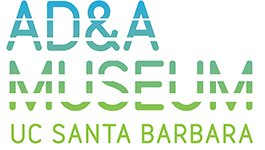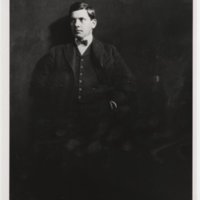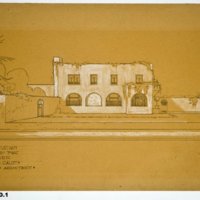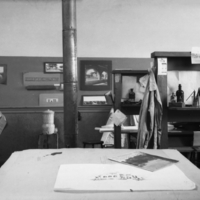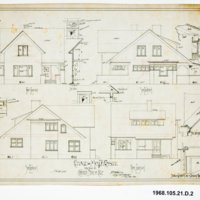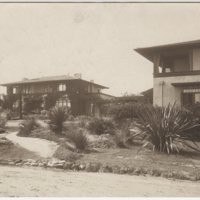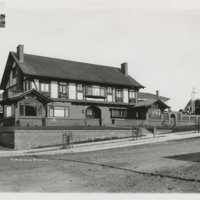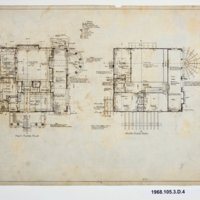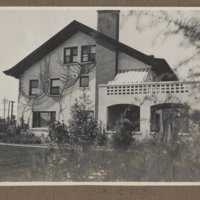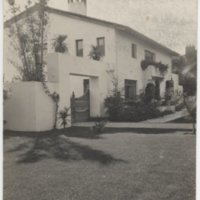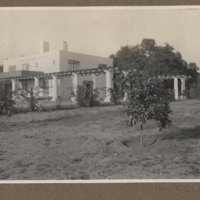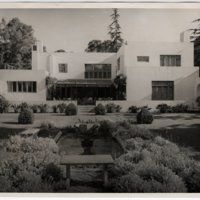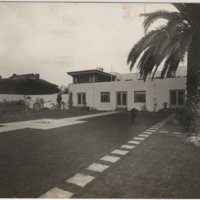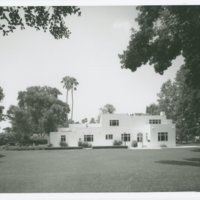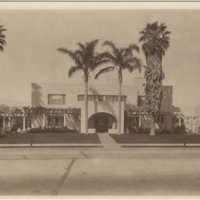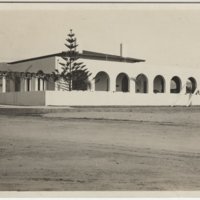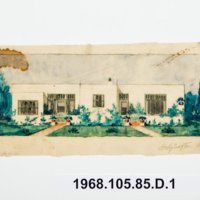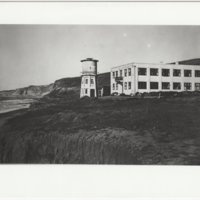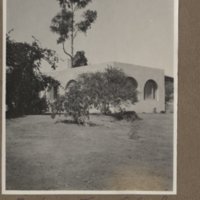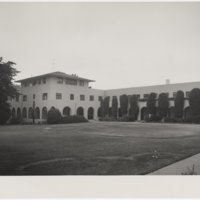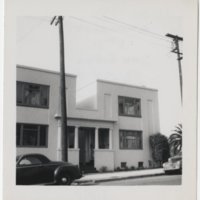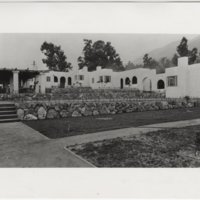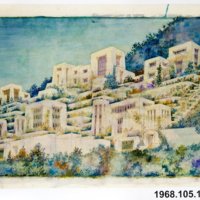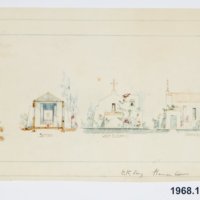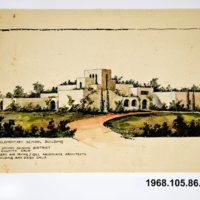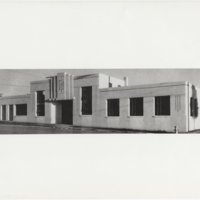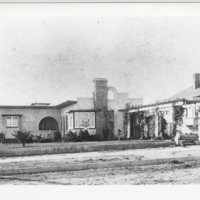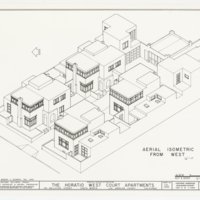Irving J. Gill (1870-1936): Simplicity and Reform
Description
Born near Syracuse, New York, Irving Gill (1870-1936) was descended from Quakers and grew up in a family with ties to the building trades; his father was a carpenter and a farmer. Gill trained in architecture through an apprenticeship with architect Ellis K. Hall in Syracuse and, based on Hall’s recommendation, moved to Chicago in 1890 to work for architect Joseph L. Silsbee. By 1891, however, Gill was in the office of Dankmar Adler and Louis Sullivan. Frank Lloyd Wright (who had earlier worked for Silsbee) was working for Sullivan at this time and later claimed that Gill worked under his guidance. The Adler and Sullivan office was engaged with the Transportation Building for the World’s Columbian Exposition of 1893. This early modern design was one of the few buildings not in the classical style for which the fair became known and highly influential, and it is likely that Gill may have worked on this project during his brief tenure in the office.
Reportedly because of ill health, Gill moved to San Diego in 1893. There he entered a short-lived partnership with Joseph Falkenham, then established in 1896 an office with William Sterling Hebbard, which lasted until 1906. In the following years Gill worked alone, though he collaborated with architect Frank Mead on a few projects between 1906-1907. Gill's nephew, Louis Gill joined the office in 1911 and became a partner around 1914. Gill increasingly spent time in the Los Angles area, doing work in Torrance and Los Angeles through the 1920s, with Louis Gill managing the San Diego office, until their partnership ended. In the late 1920s, Gill designed several projects, many unrealized, in collaboration with San Diego architect John Siebert.
Gill published several essays during his lifetime, in which he argued for a simple and authentic architecture, famously writing, “[a]ny deviation from simplicity results in a loss of dignity.” Many of his projects show his social concerns for the poor and working men and women, as in his houses for working men and single women, and his designs for the Rancho Barona Indian resettlement village in Lakeside, California.
Reportedly because of ill health, Gill moved to San Diego in 1893. There he entered a short-lived partnership with Joseph Falkenham, then established in 1896 an office with William Sterling Hebbard, which lasted until 1906. In the following years Gill worked alone, though he collaborated with architect Frank Mead on a few projects between 1906-1907. Gill's nephew, Louis Gill joined the office in 1911 and became a partner around 1914. Gill increasingly spent time in the Los Angles area, doing work in Torrance and Los Angeles through the 1920s, with Louis Gill managing the San Diego office, until their partnership ended. In the late 1920s, Gill designed several projects, many unrealized, in collaboration with San Diego architect John Siebert.
Gill published several essays during his lifetime, in which he argued for a simple and authentic architecture, famously writing, “[a]ny deviation from simplicity results in a loss of dignity.” Many of his projects show his social concerns for the poor and working men and women, as in his houses for working men and single women, and his designs for the Rancho Barona Indian resettlement village in Lakeside, California.
Creator
Irving Gill, architect
Source
Irving John Gill papers, Architecture and Design Collection. Art, Design & Architecture Museum, University of California, Santa Barbara
Date
circa 1893- circa 1936
Rights
Transmission or reproduction of materials protected by copyright beyond that allowed by fair use requires the written permission of the copyright owners. Copyright restrictions also apply to digital representations of the original materials. Works not in the public domain cannot be commercially exploited without permission of the copyright owner. Responsibility for any use rests exclusively with the user. University of California Regents.
Collection Items
Irving J. Gill (1870-1936): portrait
This early photograph of Irving Gill, from circa 1898, shows him soon after he moved to the San Diego area from Chicago. Gill is dressed in a suit with a bow tie and is looking away from the camera. It is one of a series of posed studio portraits…
Irving J. Gill: Barker house (San Diego, Calif.)
Gill used simplicity, symmetry and strategic asymmetry in his landscapes and buildings. Garden walls extend the building volume across the site, while also enclosing gardens and terraces.
In this series of drawings of graphite and gouache on board…
In this series of drawings of graphite and gouache on board…
Irving J. Gill: Gill office (San Diego, Calif.)
The photograph in the reception area of the office depicts the Mission Basilica San Diego de Alcalá, the first Franciscan mission in New Spain. William Hebbard and Irving Gill (Hebbard and Gill partnership, 1896-1907) stabilized the building in…
Irving J. Gill: Cositt house elevations (Coronado, Calif.)
The designs from the Hebbard and Gill partnership were eclectic, leaning toward English cottages with Arts and Crafts influence, but included Neo-classical, Gothic, Queen Anne, Mission Revival, and Prairie School styles.
In this drawing of a…
In this drawing of a…
Irving J. Gill: Alice Lee and Katherine Teats houses (San Diego, Calif.)
Alice Lee (a San Diego socialite and second cousin of Theodore Roosevelt’s first wife) and Katherine Teats commissioned two distinct house groups from Gill. In 1905 Gill designed a house for Lee and Teats on Seventh Avenue, with adjacent rental…
Irving J. Gill: Wangenheim house (San Diego, Calif.)
Hebbard and Gill designed an English cottage for Wangenheim, a civic leader, owner of a grocery store business, and the father-in-law of Melville Klauber, another Gill client. San Diego was a small town and Hebbard and Gill worked with most of its…
Irving J. Gill: Bailey house (La Jolla, Calif.)
Frank Mead worked in the Hebbard and Gill office beginning about 1904. He and Gill formed a seven-month partnership in 1907, when the H & G partnership ended. Before joining the office, Mead, though trained as an architect, worked actively, and…
Irving J. Gill: Klauber house (San Diego, Cailf.)
This house had a simplified exterior form, with a slight Japanese flavor in the tilt of the roof, and a warm Arts and Crafts interior.
Melville Klauber was from San Diego’s growing merchant class, and married to the sister of Julius Wangenheim.…
Melville Klauber was from San Diego’s growing merchant class, and married to the sister of Julius Wangenheim.…
Irving J. Gill: Laughlin house (Los Angeles, Calif.)
This is the first Los Angeles building that Gill designed on his own. The house has a classic center hall plan and an enclosed outdoor court. He typically oriented his plans so that one was drawn toward the light and landscape at the back of the…
Irving J. Gill: Miltmore house (South Pasadena, Calif.)
The austere Miltmore house is generously “ornamented by nature.” Gill sited the house to preserve the many trees on the sprawling lot and placed long loggias alongside the front and rear elevations. The interior is gracious though simple,…
Irving J. Gill: Dodge house (Los Angeles, Calif.)
The Dodge house was located on Kings Road, just north of the future site of Schindler’s own 1921 house. Considered Gill’s masterpiece, the design was widely praised for, as historian Leland Roth wrote," revealing a functional asymmetry whose…
Irving J. Gill: Timken house (San Diego, Calif.)
This 18-room house built for the steel manufacturer, Henry Timken, was Gill’s largest to date. Gill placed the house close to the street, leaving room for enclosed courts and a large garden. Eloise Roorbach’s contemporary article noted that the…
Irving J. Gill: Clarke house (Santa Fe Springs, Calif.)
Built on 60 acres of orange groves, the Clarke estate was Gill’s last major residential project. Constructed of poured in place reinforced concrete, the house measures 8,000 square feet. Gill’s drawings note that Gill and Pearson built the house…
Irving J. Gill: Ellen Scripps house (La Jolla, Calif.)
A book could be written about Gill’s women clients, and Ellen Scripps would be a significant chapter. She helped her brothers build a successful newspaper business and moved to La Jolla in 1897, when the town had “cow paths in lieu of streets.”…
Irving J. Gill: La Jolla Women's Club (La Jolla, Calif.)
Gill’s notes about the concrete work for the Club and the sequential construction photographs provide unusual detail for one of Gill’s significant civic designs.
Robert H. Aiken is usually credited as the tilt-up pioneer in the U.S; he…
Robert H. Aiken is usually credited as the tilt-up pioneer in the U.S; he…
Irving J. Gill: Holly Sefton Memorial Hospital (San Diego, Calif.)
Gill’s intention was to make his buildings as efficient as possible, and that is certainly true for this hospital, funded by Joseph Sefton and built on the grounds of the Children’s Home. The hospital was built of concrete to make it easy to keep…
Irving J. Gill: Scripps Biological Station (La Jolla, Calif.)
Gill’s austere clarity was especially suited to pragmatic building programs, such as the concrete Biological Station. Ellen Scripps funded the building, now part of the University of California, in honor of her brother George.
Irving J. Gill: Bishop's Day School (San Diego, Calif.)
Bishop Johnson lived in Pasadena and the Episcopal Church originally planned to build a preparatory school in Sierra Madre. When Ellen Scripps and her sister Elizabeth Virginia Scripps offered to be benefactors, the decision was made to build a day…
Irving J. Gill: Bishop's School for Girls (La Jolla, Calif.)
In the Woman’s Club, the La Jolla Playground Community House, and here in the Bishop’s School, Gill used an arcaded screen wall as a unifying element, and to articulate his austere geometry with rhythmic voids. Scripps Hall was built in 1910,…
Irving J. Gill: Darst flats (San Diego, Calif.)
Gill designed two identical buildings bisected by a walkway from the street to the rear of the property. The floor plan for both buildings shows the mirror image of the first and second floors. Each building contained two two-bedroom apartments, with…
Irving J. Gill: Lewis- Bella Vista Terrace court (Sierra Madre, Calif.)
Gill’s site planning was especially successful in this project. He pushed the cottages to the outside edge of the plot to leave a large public area for shared gardens and a loggia. He also placed each L-shaped cottage so that its arcaded porch and…
Irving J. Gill: Laughlin Park Casa Grandes development (Los Angeles, Calif.)
The Los Angeles Herald published several articles announcing the luxury housing development at Laughlin Park. A 1912 article announced that Gill was in charge of all planning for this Hollywood Hills development on a site of three acres. Another…
Irving J. Gill: Rancho Barona Resettlement project (near Lakeside, Calif.)
The architect and planner Frederick Gutheim worked for the Bureau of Indian Affairs in the 1930s. His letters to architectural critic Esther McCoy and to Louis Gill describe his friendship with Irving Gill and the Barona Resettlement project they…
Irving J. Gill: South Bay Union School (San Diego, Calif.)
Gill designed a number of schools. A 1913 article about his concrete public school for the City of Fontana praised the large outdoor playground and quoted Gill as saying that the basement playroom is “the most glaring evil in school room…
Irving J. Gill: Daily Blade-Tribune building (Oceanside, Calif.)
In the last year of his life, with the Depression still strong, Gill designed at least four buildings, of which only the Blade-Tribune newspaper building and a beauty parlor in Redondo Beach were built. In 1936 he was working on a theater with Zara…
Irving J. Gill: Gill cottages (San Diego, Calif.)
Gill designed approximately eight cottages for parcels of land he purchased in San Diego. There is little documentation for these, but all or most of the houses seem to have been built on Albatross, Front, Robinson Mews, and Hawthorne streets.Gill…
Irving J. Gill: Horatio West court (Santa Monica, Calif.)
Gill helped Schindler and Claude Chase form and raise the tilt-slab walls for the Schindler house on Kings Road, 1921. Invoices in the Schindler archive show that Schindler rented some of Gill’s equipment for the concrete work. Chase assisted Gill…
